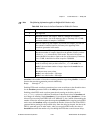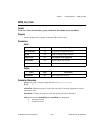
Chapter 2 Function Reference — WFM_Op
©
National Instruments Corporation 2-435 NI-DAQ FRM for PC Compatibles
The DSA devices have 18-bit DACs and operate in bipolar mode only. Data will range from
–131,072 to +131,071. For DSA devices each buffer element is 32 bits wide. Each data point
goes in the upper 18 bits of its buffer element. You should set the lower bits to zero.
count is the number of points in your buffer. When NI-DAQ is using interleaved waveform
generation, count should be a multiple of numChans and not less than 2 * numChans.
Range: 1 through 2
32
– 1 (except E Series devices).
2 through 2
24
(E Series devices).
On PCI-61XX devices, the buffer must contain an even number of samples because of the
32-bit FIFO.
iterations is the number of times the waveform generation steps through buffer. A value of
0 means that waveform generation proceeds indefinitely.
Range: 0 through 2
32
– 1.
rate is the rate of waveform generation you want in points per second (pts/s). A value of
0.0 for rate means that external update pulses (applied to OUT2 for the MIO-16 and
AT-MIO-16D, to EXTDACUPDATE for the AT-MIO-16F-5, AT-MIO-64F-5, and
AT-MIO-16X, to EXTUPDATE for the AT-AO-6/10 and Lab and 1200 Series analog output
devices, and to PFI Pin 5 on E Series devices) will determine the waveform generation rate.
Range: 0.0 for external update or approximately 0.0015 to 500,000 pts/s.
Your maximum rate depends on your device type and your computer system. If the number
of points that represents represent one cycle of the waveform equals count, the frequency of
the generated waveform is related to the rate by this the following formula:
frequency = (rate/count) cycles/s
Using This Function
WFM_Op initiates a waveform generation operation. NI-DAQ writes the data in the buffer to
the specified analog output channels at a rate as close to the rate you want as the specified rate
hardware permits (see
WFM_Rate for a further explanation). With the exception of indefinite
waveform generation,
WFM_Op waits until NI-DAQ completes the waveform generation is
complete before returning (that is, it is synchronous).
(AT-MIO-16F-5 only) If you have aligned the buffer with a previous call to
Align_DMA_Buffer, WFM_Op automatically indexes into the buffer at the new starting point
if necessary. If the call to
WFM_Op is synchronous, when the function returns, the buffer is
unaligned. That is, the data samples will start at index 0 of the buffer. If the waveform
generation is indefinite, the buffer remains aligned until you call
WFM_Group_Control
(operation = CLEAR).


















